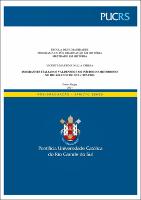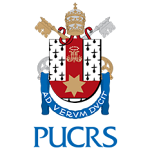| Share record |


|
Please use this identifier to cite or link to this item:
https://tede2.pucrs.br/tede2/handle/tede/11403| Document type: | Dissertação |
| Title: | Imigrantes italianos valdenses e os inícios do metodismo no Rio Grande do Sul (1887 -1900) |
| Author: | Dalla Chiesa, Vicente Martins  |
| Advisor: | Ruggiero, Antonio de |
| Abstract (native): | A colônia italiana do Rio Grande do Sul ainda é vista, no senso comum e por parte da historiografia mais tradicional, como um território de grande homogeneidade cultural e especialmente religiosa. No entanto, a região colonial italiana da Serra Gaúcha recebeu um pequeno número de imigrantes evangélicos de confissão valdense, os quais, em 1887, entraram em contato com o representante, no Rio Grande do Sul, da Missão Metodista no Rio da Prata. A partir desse ano, a assistência religiosa desses italianos passou a ficar a cargo da Igreja Metodista Episcopal dos Estados Unidos (IME). Os imigrantes valdenses vindos ao Rio Grande do Sul tiveram duas origens: os estabelecidos nas colônias Dona Isabel e Alfredo Chaves vieram de localidades nas províncias de Treviso e Udine, as quais já vinham sendo atendidos pela Igreja Valdense. Aqueles estabelecidos na Forqueta Baixa, interior da colônia Caxias, eram oriundos dos vales do Piemonte Ocidental, área de ocupação valdense multissecular. As comunidades foram organizadas em dois circuitos (áreas com diversos pontos de pregação, sendo um central), um com sede em Bento Gonçalves/Dona Isabel e outro na Forqueta Baixa, cada um deles atendido por um pastor residente, italianos natos deslocados dos países platinos pela administração metodista. Organizou-se uma igreja evangélica de língua italiana - situação rara no contexto brasileiro - e nessa mesma área foram edificados os três primeiros templos metodistas do Rio Grande do Sul. A comunidade protestante regional cresceu em ritmo acelerado até o advento da Revolução Federalista (1893-1895), que convulsionou o Rio Grande do Sul. No período seguinte, a partir de 1896, passam a atuar na colônia italiana ordens religiosas católicas vindas da Europa, cuja atividade entra em confronto com os planos metodistas de expansão. Em 1900, a atividade metodista nesse Estado passa a ser dirigida por outra denominação, a Igreja Metodista Episcopal, Sul (IMES), e se inaugura uma nova fase do Metodismo gaúcho. |
| Abstract (english): | The Italian colony of Rio Grande do Sul is still seen, in common sense and by more traditional historiography, as a territory of great cultural and especially religious homogeneity. However, the Italian colonial region of Serra Gaúcha received a small number of evangelical immigrants of Waldensian confession, who, in 1887, came into contact with the representative in Rio Grande do Sul of the Methodist Mission in Rio da Prata. From that year onwards, religious assistance for these Italians was under the responsibility of the United Methodist Episcopal Church (IME). The Waldensian immigrants coming to Rio Grande do Sul had two origins: those established in the Dona Isabel and Alfredo Chaves colonies came from locations in the provinces of Treviso and Udine that were already being served for some years by the Waldensian Church. Those established in Forqueta Baixa, in the interior of Caxias colony, came from the valleys of Western Piedmont, an area of multi-century Waldensian occupation. The communities were organized into two circuits (areas with several preaching points, one being central), one based in Bento Gonçalves/Dona Isabel and the other based in Forqueta Baixa, each of them attended by a resident pastor, native Italians displaced from the Río de la Plata region by the Methodist administration. An Italian-speaking evangelical church was organized - a rare situation in the Brazilian context - and the first three Methodist temples in Rio Grande do Sul were built in this same area. The regional Protestant community grew at an accelerated pace until the advent of the Federalist Revolution (1893-1895), which convulsed Rio Grande do Sul. In the following period, from 1896 onwards, Catholic religious orders from Europe began to operate in the Italian colony, whose activity came into direct conflict with the Methodist expansion plans. In 1900, Methodist activity in that State began to be directed by another denomination, the Methodist Episcopal Church, South (IMES), and a new phase of Gaucho Methodism began. |
| Keywords: | Imigração Italiana no Rio Grande do Sul Religiosidade Igreja Metodista Igreja Valdense Italian Immigration in Rio Grande do Sul Religiosity Methodist Church Waldensian Church Immigrazione italiana nel Rio Grande do Sul Religiosità Chiesa Metodista Chiesa Valdese |
| CNPQ Knowledge Areas: | CIENCIAS HUMANAS::HISTORIA |
| Language: | por |
| Country: | Brasil |
| Publisher: | Pontifícia Universidade Católica do Rio Grande do Sul |
| Institution Acronym: | PUCRS |
| Department: | Escola de Humanidades |
| Program: | Programa de Pós-Graduação em História |
| Access type: | Acesso Aberto |
| Fulltext access restriction: | Trabalho será publicado como artigo ou livro |
| Time to release fulltext: | 06 meses |
| Date to release fulltext: | 28/04/2025 |
| URI: | https://tede2.pucrs.br/tede2/handle/tede/11403 |
| Issue Date: | 23-Aug-2024 |
| Appears in Collections: | Programa de Pós-Graduação em História |
Files in This Item:
| File | Description | Size | Format | |
|---|---|---|---|---|
| DIS_VICENTE_MARTINS_DALLA_CHIESA_COMPLETO.pdf | VICENTE_MARTINS_DALLA_CHIESA_DIS | 6.5 MB | Adobe PDF |  Download/Open Preview |
Items in DSpace are protected by copyright, with all rights reserved, unless otherwise indicated.




